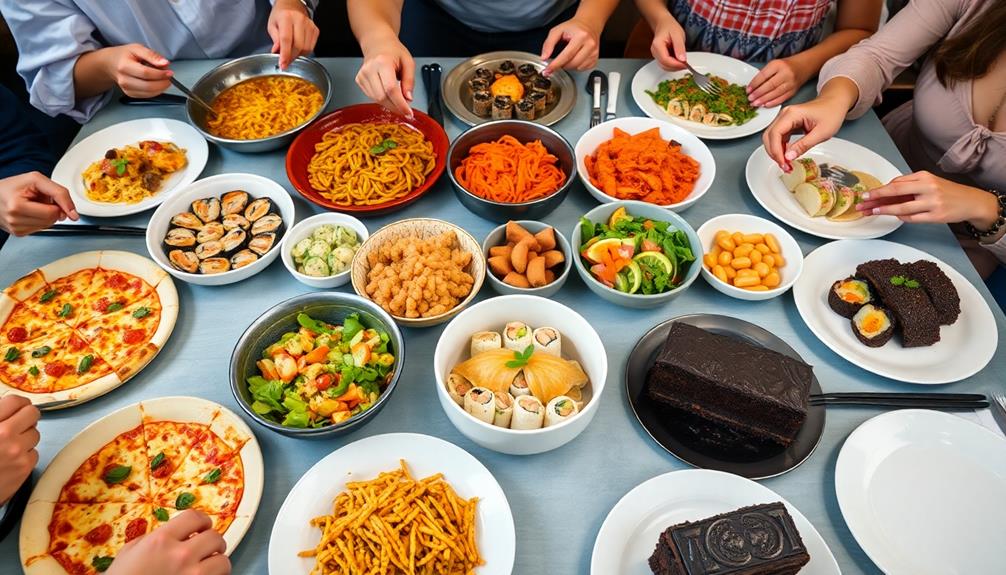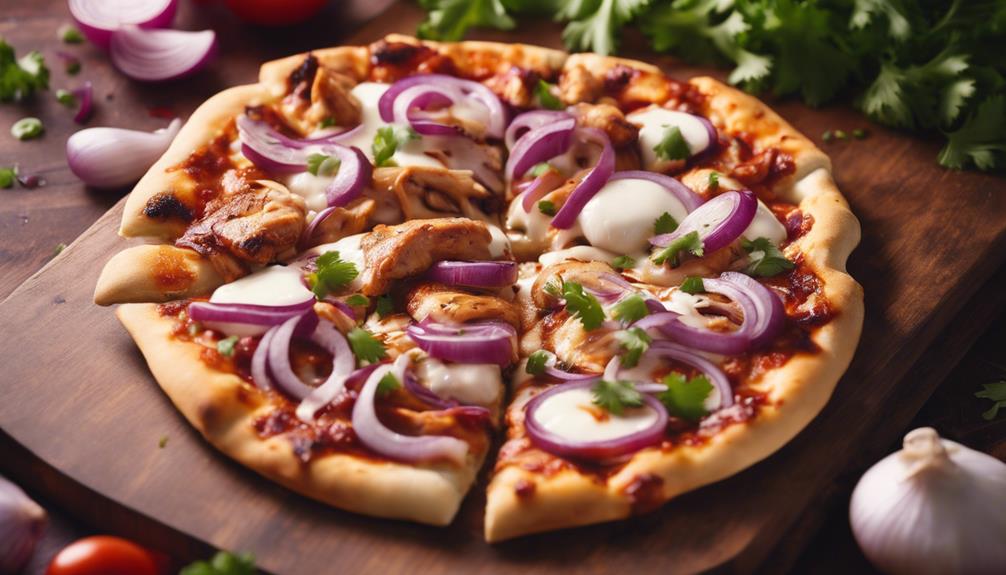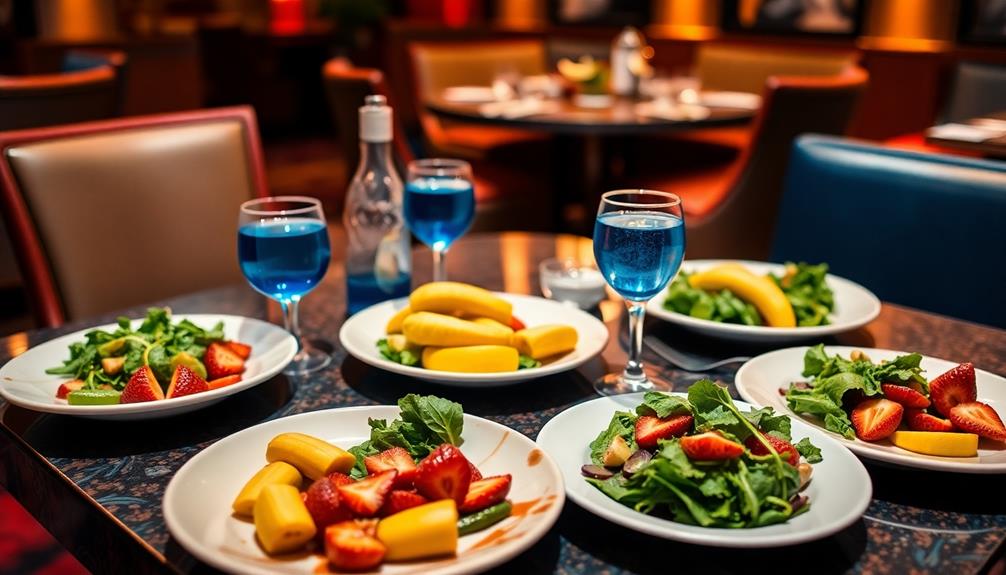Certain foods are universally loved because they connect us emotionally and culturally. Think of your favorite comfort food; it likely brings back cherished memories and feelings of warmth. You may find joy in sharing meals with loved ones, strengthening your bonds and creating lasting memories. Foods like pasta and rice are not just staples; they symbolize tradition and community. As you savor these flavors, you weave together personal experiences and cultural significance. Every bite holds a story. If you're curious about how these elements come together to make food so beloved, there's much more to explore.
Key Takeaways
- Universal meals like pasta and rice are versatile and easily adaptable, appealing to diverse tastes and cultures worldwide.
- Comfort foods evoke nostalgia, triggering warm memories that foster emotional connections and shared experiences among individuals.
- Shared meals and culinary traditions enhance social ties, creating a sense of belonging and community through food.
- The emotional impact of food, tied to personal stories and memories, makes certain dishes universally cherished across different backgrounds.
- Cultural significance of food reflects community heritage, allowing unique flavors and ingredients to resonate with people on a global scale.
Food as a Love Language
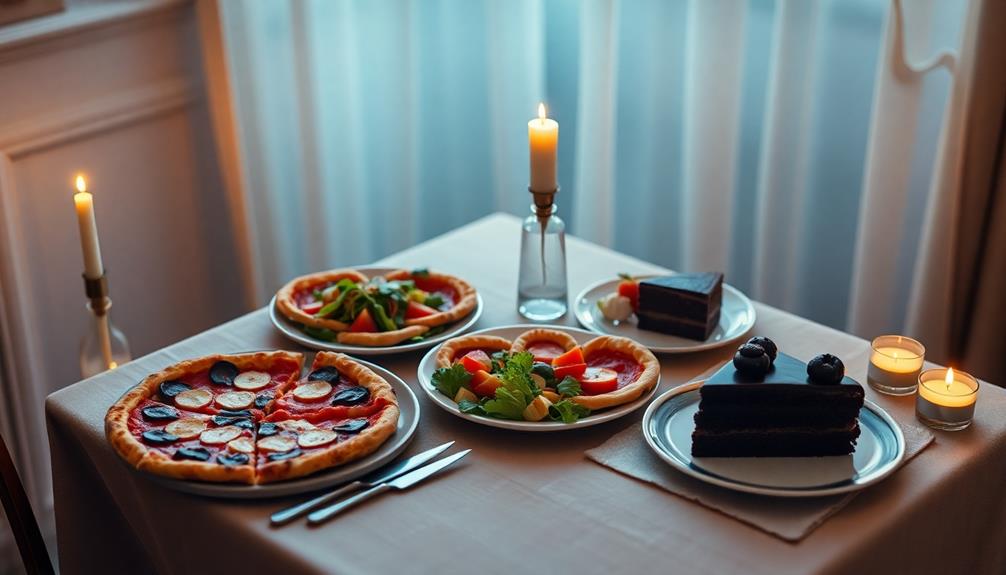
When you think about how you express love, food often plays a central role. In fact, 64% of people see food as their primary love language. This highlights just how essential it's to convey affection and care through meals.
For instance, preparing a traditional dish like Dorayaki (Red Bean Pancake) can evoke cherished memories and strengthen emotional connections. You might've even found yourself pretending to enjoy a meal to spare someone's feelings—almost 70% of folks have done that. This emotional weight attached to food illustrates its power in relationships.
Surprising loved ones with their favorite foods is another way you show love. About 48% of people do this, creating joyful moments that strengthen bonds. Similarly, 53% of individuals have gone the extra mile, cooking or buying a meal specifically to say, "I Love You." These culinary gestures communicate deep feelings that words sometimes can't capture.
Moreover, food fosters connection within families, with 67% of parents bonding with their children over shared meals. Whether it's a comforting bowl of mac and cheese or a homemade cake, comfort food can evoke warmth and togetherness.
Comfort Foods and Nostalgia
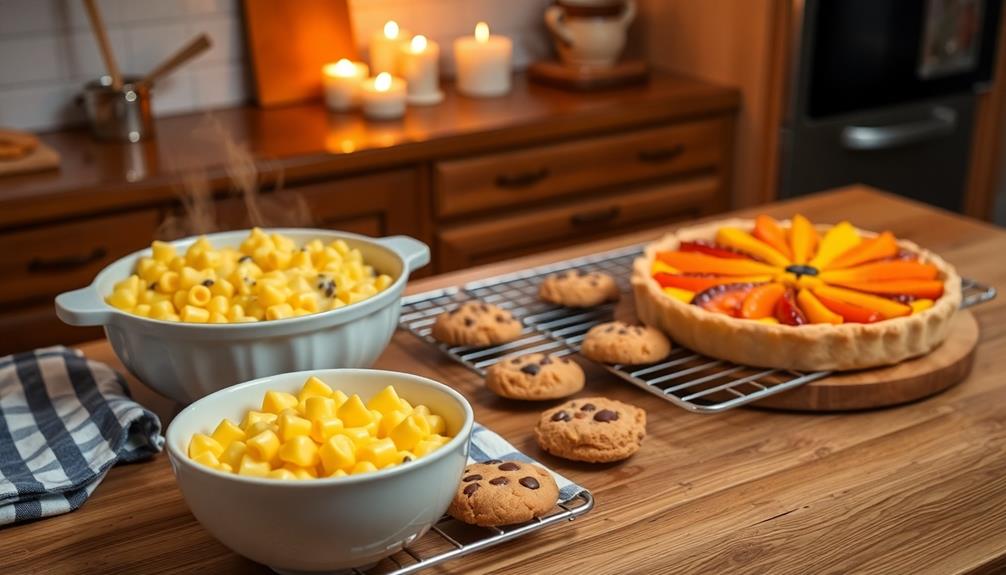
Comfort foods often transport you back to cherished moments, weaving nostalgia into each bite. Think about those family gatherings where mac and cheese took center stage, its creamy texture and rich flavors wrapping you in warmth.
Dishes like squash casserole evoke memories of shared meals, showcasing the comforting embrace of Southern cuisine. These dishes evoke memories of childhood, reinforcing the emotional connections that make comfort foods universally loved.
Surprisingly, nearly 64% of people prefer homemade meals over store-bought options. This preference highlights how deeply rooted these comfort foods are in personal experiences and family traditions. Each plate carries a story, and every spoonful reminds you of shared laughter and love.
The versatility of comfort foods also plays a significant role in their charm. You can customize them with various ingredients, adapting to different dietary needs without losing that nostalgic essence.
And let's not forget the impact of popular culture—seeing comfort foods in movies or at food festivals reinforces their status as symbols of indulgence and warmth.
Ultimately, comfort foods are more than just meals; they're a bridge to the past, reminding you of the joy found in simple, satisfying dishes.
Cultural Significance of Food

Food isn't just about sustenance; it's a key part of your cultural identity and shared traditions.
Different cuisines, like Brazilian dishes such as Caldeirada, showcase the unique flavors and ingredients that reflect the history and heritage of a community.
When you gather around a meal, you're not just eating—you're participating in a rich tapestry of stories and connections that bind communities together.
Comfort foods from various cultures often evoke memories that reinforce these bonds, reminding you of the warmth and familiarity that food brings.
Food as Cultural Identity
At the heart of every culture lies a rich tapestry of culinary traditions that connect people to their heritage and one another. Food isn't just sustenance; it's a powerful connector to cultural identity. Comfort foods often evoke nostalgia, reminding you of family gatherings and cherished memories tied to specific traditions.
| Cultural Element | Explanation |
|---|---|
| Comfort Foods | Dishes that evoke nostalgia and emotional ties. |
| Culinary Traditions | Unique methods and ingredients that define communities. |
| Food Festivals | Celebrations that promote cultural diversity and understanding. |
| Emotional Connections | Food experiences that bridge gaps between diverse backgrounds. |
These culinary traditions reflect the history and identity of your community, showcasing flavors that tell your story. Shared meals often lead to storytelling, reinforcing the significance of food in preserving cultural heritage. When you partake in communal meals or attend food festivals, you celebrate not just the flavors but also the diverse narratives they carry. Ultimately, food becomes a universal language, fostering relationships and building community across different backgrounds. Through comfort foods, you can find common ground, transcending barriers and embracing the rich diversity of human experiences.
Shared Meals and Traditions
Sharing a meal brings people together in a way that few other activities can. It's during these shared meals that you create bonds, celebrate milestones, and forge memories. Cultural traditions often revolve around food, making it central to events like birthdays and weddings.
For instance, dishes such as Nasi Tumpeng symbolize gratitude and celebration in Indonesian culture, showcasing how food plays a crucial role in communal gatherings.
Here are a few reasons why shared meals hold such significance:
- Strengthening Connections: When you gather with family or friends over food, you deepen your relationships and enhance social ties.
- Storytelling Medium: Every dish tells a story, allowing you to share your heritage and experiences, enriching the meal with cultural exchange.
- Culinary Traditions: Specific foods tie back to local customs and family practices, representing the history and identity of your community.
- Emotional Resonance: The act of sharing meals often evokes nostalgia and comfort, reinforcing food's role as a unifying force across diverse backgrounds.
In essence, shared meals are more than just a way to nourish the body; they cultivate a sense of belonging and connection, reminding you of the importance of community in your life.
Comfort Foods Across Cultures
When you think of comfort foods, it's hard not to feel a wave of nostalgia wash over you, as these dishes often evoke cherished memories of childhood and family gatherings. Across various cultures, comfort foods serve as a bridge that connects generations and brings people together.
In America, mac and cheese warms your heart, while in Italy, a creamy risotto offers solace. In China, a bowl of congee provides comfort during chilly mornings, much like Red-Braised Pork Belly which is often enjoyed during family gatherings.
These comfort foods don't just satisfy hunger; they symbolize connection and tradition. They often take center stage during communal meals, reinforcing bonds during celebrations and gatherings.
The cultural significance of these dishes is further highlighted in popular media, where they're depicted as symbols of warmth and indulgence, reminding you of home.
What makes comfort foods particularly special is their adaptability. Local variations incorporate unique regional ingredients, allowing each culture to personalize its comfort food experience.
This adaptability enhances their global popularity and relevance, making comfort foods a universal language of love and connection.
Universal Meals Across Cultures
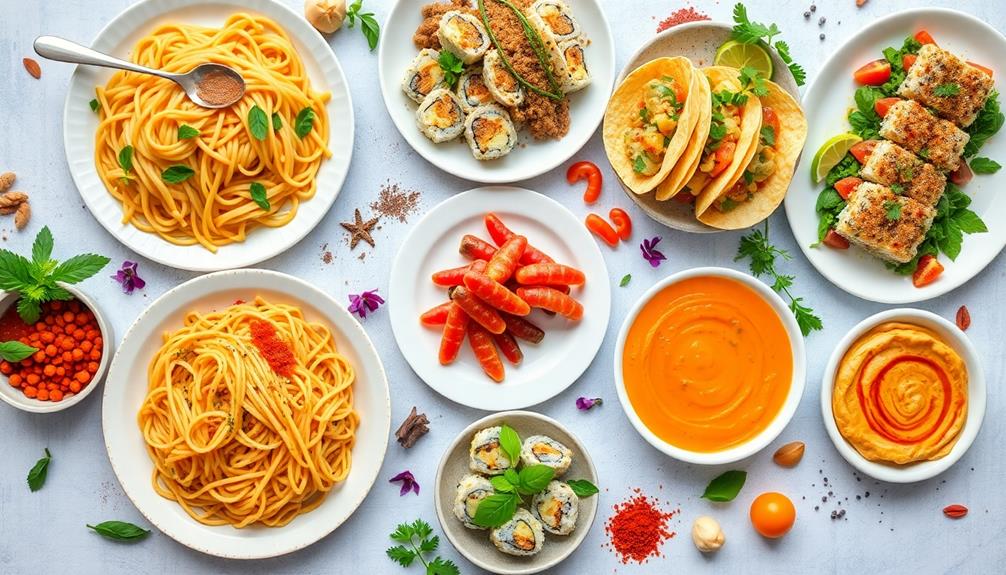
Exploring universal meals across cultures reveals a fascinating tapestry of flavors and traditions that connect people around the globe. When you experience these dishes for the first time, you'll notice how they transcend boundaries and bring joy.
For example, Mexican cuisine features dishes like Chilaquiles, a delightful breakfast option that showcases the creativity of using leftover ingredients.
Here are some universal meals that stand out:
- Pasta: Whether it's spaghetti in Italy or noodles in Asia, this versatile food is loved worldwide for its adaptability.
- Rice: A staple in countless cultures, rice serves as the base for meals like sushi in Japan and paella in Spain, showcasing its global significance.
- Bread: From naan in India to baguettes in France, bread is a fundamental part of meals and social gatherings, connecting people through shared experiences.
- Desserts: Cakes and pastries are universally cherished. Whether you try baklava in the Middle East or tiramisu in Italy, these sweet treats highlight a shared love for indulgence.
These universal meals not only satisfy hunger but also create a sense of belonging, inviting you to explore diverse culinary traditions while celebrating the similarities that unite us all.
Social Connections Through Food

Food serves as a powerful medium for forging social connections, bringing people together in ways that transcend language and culture. When you share good food with others, you're not just offering a meal; you're expressing care. In fact, 67% of people believe that sharing favorite food symbolizes caring, highlighting its significance in building relationships.
You might even recall instances when you've pretended to enjoy a meal to avoid hurting someone's feelings—nearly 70% of individuals have done the same, showing how food can navigate social dynamics. Dishes like Turkey Soup or homemade treats like Pumpkin Roll not only provide comfort but also create opportunities for togetherness.
Homemade meals, like your favorite snack trays, also play an essential role in expressing affection. About 61% of people prepare these for loved ones, reinforcing bonds through shared tastes.
Family meals have long been cherished for their ability to strengthen relationships; 67% of parents bond with their children over food, creating lasting memories.
Moreover, celebratory events such as birthdays and weddings often revolve around good food, enhancing the joy of these occasions.
Ultimately, it's clear that food is much more than sustenance; it's a bridge that connects us, deepening our social ties and enriching our lives.
The Role of Chefs and Cooks

Sharing meals goes beyond just the act of eating; it involves the talents and passions of chefs and cooks who bring these experiences to life. Their influence shapes not only the food you enjoy but also the memorable moments that foster community bonds.
For instance, dishes like Nettle and Potato Soup highlight the importance of seasonal ingredients, allowing chefs to create flavors that resonate with the time of year.
Here are four ways chefs and cooks make a difference:
- Creating Memories: Chefs and cooks weave personal stories into dishes, making meals meaningful and emotionally resonant.
- Fostering Community: Shared meals in kitchens promote equality among staff, emphasizing collaboration in the culinary world.
- Linking Artistry and Responsibility: The culinary arts blend creativity with the responsibility of nurturing social and emotional well-being, enhancing your dining experience.
- Continuous Learning: Professional chefs and cooks engage in ongoing education, improving their skills and understanding how food impacts community engagement.
The dedication of chefs and cooks goes beyond just preparing food; they craft experiences that connect people.
Their artistry and commitment guarantee that meals aren't just eaten, but celebrated, creating bonds that last long after the last bite is taken.
Taste Perception Influences
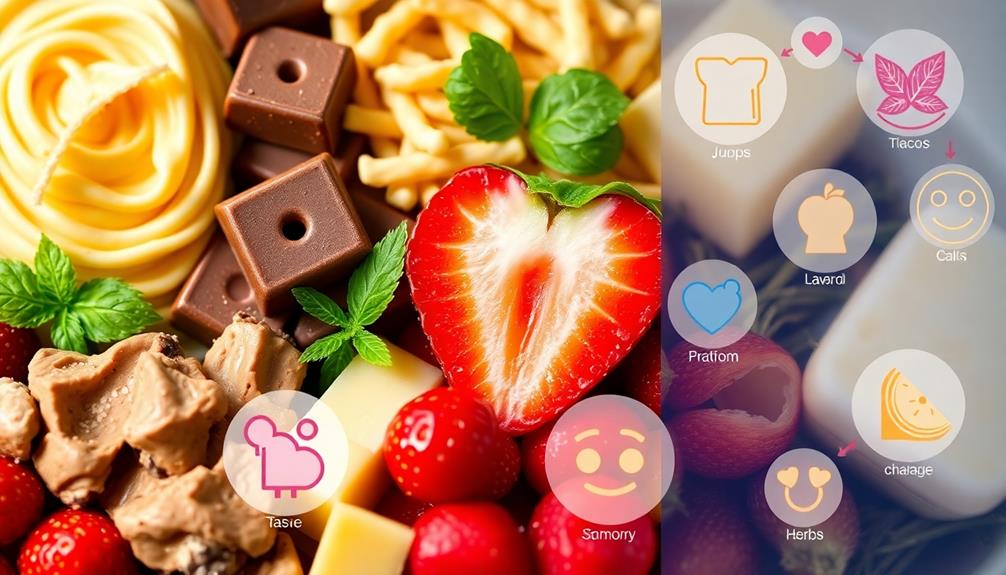
Throughout life, your taste perception is shaped by a complex interplay of biological and psychological factors. Genetics plays a role; for example, some people are supertasters, as highlighted by Linda Bartoshuk's research. This heightened sensitivity can drastically influence food preferences, making certain flavors more pronounced and enjoyable—or off-putting—for you.
The rich and diverse flavors found in dishes like Mushroom Masala or the bold spices of Chicken Chettinad can evoke strong emotional responses and create lasting memories tied to those foods.
Your early experiences with food also play a vital role in shaping your taste perception. The foods you're introduced to during childhood, often dictated by cultural practices, can create lifelong preferences. If you associate a particular dish with positive family memories, you're more likely to enjoy it later in life. Conversely, negative experiences can lead to aversions that last for years.
Cultural upbringing further influences your taste perception, as different societies celebrate unique flavors and textures. Additionally, media coverage of food trends can broaden your awareness and curiosity about unfamiliar dishes.
As you navigate through these influences, taste perception becomes a tapestry woven from genetics, personal experiences, and cultural context, ultimately guiding your food choices and preferences throughout your life. Understanding these factors can enhance your appreciation for the foods you love and those you may yet discover.
Food Sharing and Community
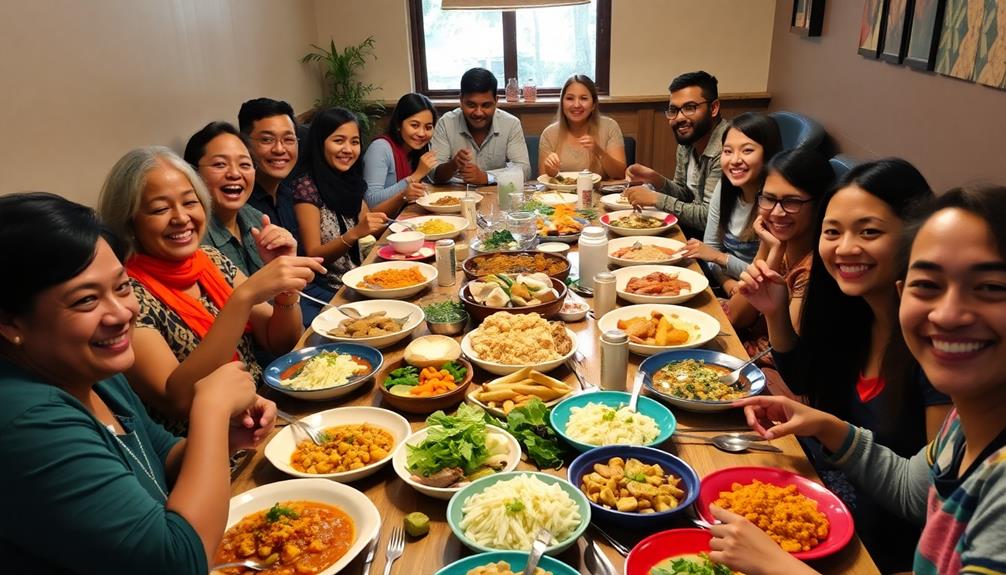
When you share your favorite dishes, you're not just feeding others; you're building bonds that strengthen your community.
For instance, traditional Ethiopian drinks like Tella and Tej are often enjoyed during celebrations, enhancing the communal experience.
Celebrating culture together through food creates lasting memories and fosters connections that go beyond the meal itself.
Whether it's a festive gathering or a simple lunch at work, shared meals have a unique way of bringing people together.
Building Bonds Through Sharing
Food has an incredible power to bring people together, and it often serves as a bridge in building connections. When you share meals, whether it's a home-cooked dish or fast food, you're expressing care and fostering bonds.
In fact, 67% of people view sharing favorite foods as a sign of caring, and nearly 59% are likely to share their meals with others. This act strengthens social ties and creates memorable experiences.
Consider these ways food sharing builds connections:
- Celebratory Events: Lunar New Year feasts exemplify how shared meals enhance camaraderie among participants.
- Workplace Gatherings: Food-related events in the office can break down barriers and strengthen team dynamics.
- Food Festivals: Communal meals at festivals promote cultural exchange and understanding, showcasing the diversity of tastes and traditions.
- Everyday Moments: Sharing a quick fast food meal with a friend can turn a simple outing into a cherished memory.
Ultimately, sharing food isn't just about nourishment; it's about creating connections that enrich our lives and foster community spirit.
Celebrating Culture Together
Celebrating culture together often happens around shared meals that highlight community values and traditions. Food serves as a unifying force; in fact, 67% of people agree that sharing favorite foods shows care, fostering deep connections within your community.
Think about how celebratory events, like Lunar New Year feasts, create opportunities for bonding and enhance the spirit of togetherness.
Restaurants also play an essential role in this cultural celebration. Independent eateries contribute not only to local economies but also to a sense of belonging. They become gathering spots where memories are made and stories are shared.
Food festivals and communal meals further promote cultural exchange and understanding, reinforcing food's role as a significant communication tool among diverse groups.
Even in workplaces, food sharing has traditionally emphasized camaraderie. Pre-COVID, communal dining experiences helped strengthen team dynamics, creating common ground among colleagues.
By coming together over a meal, you foster connections that transcend individual differences, helping everyone feel included and valued.
Ultimately, celebrating culture through shared food cultivates a sense of community that enriches our lives and brings people closer.
Emotional Impact of Food
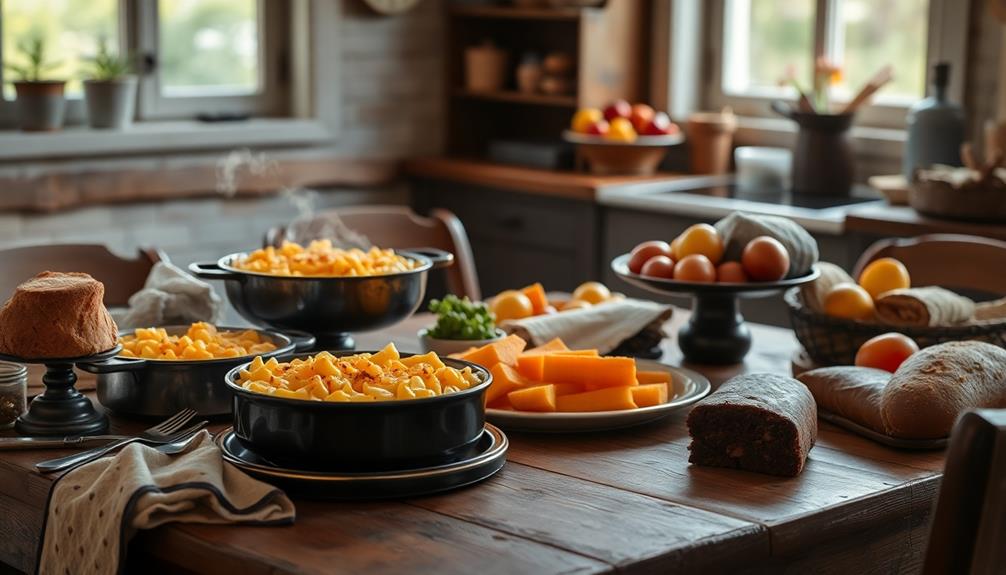
The emotional impact of food runs deep, touching on our experiences and memories in profound ways. You mightn't realize it, but food often serves as a source of comfort during various emotional states, providing solace when you're happy, sad, lonely, or stressed.
Here are some ways food's emotional impact manifests in our lives:
- Nostalgia: Comfort foods frequently evoke childhood memories, making you feel warm and connected to your past.
- Social Connections: Nearly 70% of people admit to pretending to enjoy a meal, highlighting how food can foster social harmony and caring.
- Shared Experiences: About 67% of folks believe that sharing favorite foods signifies care, reinforcing bonds with loved ones.
- Meaningful Preparation: Cooking from scratch is viewed as more significant by 25% of people, showing the emotional investment tied to homemade meals.
When you think about it, every bite carries a story. Whether it's a family recipe or a meal shared with friends, the emotional impact of food shapes your experiences and memories, making it universally loved.
Frequently Asked Questions
What Is the Most Universally Liked Food?
You might find pizza tops the list as the most universally liked food, loved for its versatility. Cookies and ice cream also rank high, appealing to many for their comforting, delightful flavors during special moments.
Why Is Food a Cultural Universal?
Isn't it fascinating how food weaves stories through generations? Food's a cultural universal because it connects you to shared memories, traditions, and experiences, fostering understanding and acceptance while reinforcing your identity within your community.
Why Do I Love Certain Foods so Much?
You love certain foods because they evoke cherished memories and emotions. Your experiences shape your preferences, while flavors resonate with your taste buds, creating lasting connections that make those foods special in your life.
Why Is Pizza so Universally Loved?
Pizza's got this incredible mix of flavors and toppings that you can customize to your liking. It's perfect for sharing, making every gathering feel special. Plus, who doesn't appreciate a delicious slice with friends?
Conclusion
In a world where food connects us all, it's fascinating to note that over 70% of people say their fondest memories are tied to meals shared with loved ones. Whether it's a comforting bowl of mac and cheese or a festive feast, food serves as a universal language that transcends boundaries. So, the next time you gather around the table, remember: you're not just sharing a meal; you're creating lasting bonds and cherished memories.
